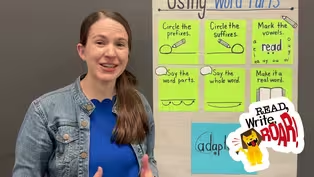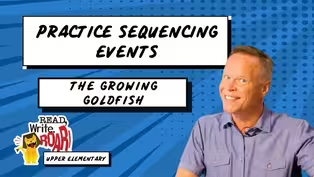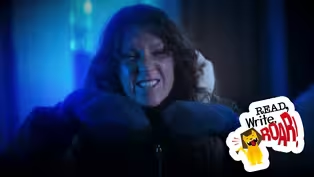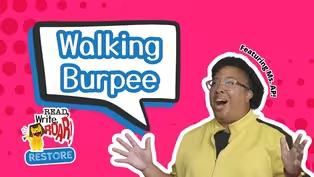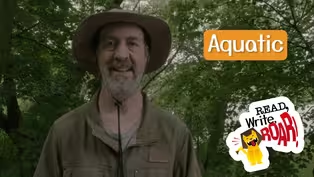Read, Write, ROAR!
Explore Wildlife in Detroit | Ms. Rodgers | Read, Write, ROAR!
Clip: Season 1 Episode 1014 | 7m 17sVideo has Closed Captions
Explore the surprising wildlife of Detroit with Ms. Rodgers.
Explore the surprising wildlife of Detroit with Ms. Rodgers! From beavers to raccoons, learn why wild animals call this busy city home and how they thrive.
Problems playing video? | Closed Captioning Feedback
Problems playing video? | Closed Captioning Feedback
Read, Write, ROAR! is a local public television program presented by Detroit PBS
Read, Write, ROAR!
Explore Wildlife in Detroit | Ms. Rodgers | Read, Write, ROAR!
Clip: Season 1 Episode 1014 | 7m 17sVideo has Closed Captions
Explore the surprising wildlife of Detroit with Ms. Rodgers! From beavers to raccoons, learn why wild animals call this busy city home and how they thrive.
Problems playing video? | Closed Captioning Feedback
How to Watch Read, Write, ROAR!
Read, Write, ROAR! is available to stream on pbs.org and the free PBS App, available on iPhone, Apple TV, Android TV, Android smartphones, Amazon Fire TV, Amazon Fire Tablet, Roku, Samsung Smart TV, and Vizio.
Providing Support for PBS.org
Learn Moreabout PBS online sponsorship[Music] you probably already know Detroit as the home of mtown cars and square pizza but did you know that Detroit is also home to a wide variety of wildlife hi everyone I'm Miss Rogers despite being a bustling City a surprise number of wild animals called Detroit home from beavers and muskrats to skunks peasants and coyotes these animals survive and even Thrive or do well in a busy City environment but why do they choose to live there to get to the bottom of this I found an article that talks about wildlife in Detroit the article by Kobe L is written in the second person and explains the perspective of one woman that lives in Detroit when we are finished reading the article I'll show you how to use a tool that will help us organize and connect new ideas and vocabulary so we can better understand what we read in Detroit's early days the land around Raquel Garcia's Southwest Detroit home was mostly Forest but that only partly explains why there are a dozen baby raccoons in her dining room Garcia is a professional environmental activist who who also puts in long hours as a volunteer Wildlife rehabilitator with the focus on raccoons raccoons in a chimney she gets a call orphan baby raccoon in a backyard she'll bring it home to the cages in her house where she'll feed it until it grows enough to survive on its own every time she brings in an animal she believes she is saving its life let's pause our reading for a moment moment we read a word that you may not be familiar with rehabilitator sometimes when you come across a new word you can use base words root words prefixes and suffixes to help you read it I've heard of a rehab which is where my grandmother went after surgery on her hip so she could get better to walk again rehab is in rehabilitator so I think maybe this has something to do with the way of getting better when injured I know that and now I can look at the surrounding words or sentences to help me figure out the meaning which is called using context clues so what Clues does this paragraph give us about what the word rehabilitator could mean she'll bring it home to the cages in her house until it grows enough to survive on its own this sentence shows that Garcia helps raccoons get better so using my own knowledge and the context clue I think a rehabilitator is someone who helps animals get better so they can live on their own again why Wildlife thrives in Detroit cities are rough places for wild animals which can get hit by cars and attacked by dogs said Cindy Russ founder of Ferndale based Motor City posum Rescue in the fall I get a lot of juvenile possums with rat trap injuries still some animals find ways to thrive in Detroit thanks in part to our low population density and large Parks beavers muskrats cottontail rabbits skunks possums groundhogs foxes coyotes and more make themselves home in Detroit favorable conditions for wildlife can lead to conflict with humans just this month the city held a meeting about goose and deer populations exploding in Rouge and Chandler parks in spreading into surrounding neighborhoods the ecosystem in those Parks has gone unbalanced said Jessica Parker Deputy Chief Operating Officer for city of Detroit excessive Goose populations can cause water quality issues at beaches while deer have caused a growing number of car crashes in metro Detroit remember the helpful tool I mentioned earlier well it's called a semantic map and it's used to help us to organize connect remember and better understand new ideas and vocabulary here's how semantic Mathew works the main topic goes in the middle and each branch connects to a related vocabulary word or idea let's make a semantic map to summarize what we've learned about wildlife in Detroit at the center of our map we'll write wildlife in Detroit since that's our main topic now let's create branches to explore different aspects of wildlife in Detroit let's start with types of wildlife I remember the article sharing some of the types of wildlife animals that are found in Detroit so add them under this Branch possum muskrats beavers cottontail rabbits now let's think about why these animals might thrive in Detroit so now let's add another branch called favorable conditions do you remember what makes Detroit an inviting place for wildlife that's right low population density or lots of open land with fewer people was the reason large parks and adaptable animal species but as you can imagine having all these animals around can sometimes lead to problems so let's add another Branch for conflicts with humans I'm going to add water quality issues deer neighborhoods more car crashes by creating this semantic map we've organized our information into subtopics around the topic it helps us to see not only what kinds of wildlife live in Detroit but also why they're able to thrive and what challenges they create for humans too organizing information like this can make even the most difficult topics easier to understand next time you're out and about take a moment to observe the wildlife around you what do you see that you can connect to the map we've made you might even use what you see to start your own map happy observing thank you for joining us if you want more fun ways to practice literacy skills don't forget to subscribe to the Michigan Learning Channel and be sure to check the description below for links to activity guides resources and more [Music] [Applause]
Adaptable & Favorable: Decoding Multisyllabic Words | Mrs. Mora | Read, Write, ROAR!
Video has Closed Captions
Clip: S1 Ep1014 | 4m 17s | What do "adaptable" and "favorable" have in common? (4m 17s)
Aquatic Intruders: Goldfish Effects | Cause and Effect for Grades 4-5
Video has Closed Captions
Clip: S1 Ep1014 | 6m 38s | Create a cause and effect chart to enhance your reading and writing skills! (6m 38s)
Create a Tundra Soundscape | Ms. Audra | Read, Write, ROAR!
Video has Closed Captions
Clip: S1 Ep1014 | 2m 15s | Imagine the sounds of avalanches, polar bears, and the icy wind as we create a winter wonderland. (2m 15s)
Read, Write, ROAR! Restore - Walking Burpee
Video has Closed Captions
Clip: S1 Ep1014 | 2m 26s | Learn the fundamentals of burpees with Ms. AP in this 2-minute movement snack. (2m 26s)
Writing About Aquatic Invasive Species | Paul Roose | Read, Write, ROAR!
Video has Closed Captions
Clip: S1 Ep1014 | 4m 40s | Learn how to identify and prevent the spread of aquatic invaders to protect the environment. (4m 40s)
Providing Support for PBS.org
Learn Moreabout PBS online sponsorship

- Home and How To

Hit the road in a classic car for a tour through Great Britain with two antiques experts.












Support for PBS provided by:
Read, Write, ROAR! is a local public television program presented by Detroit PBS
